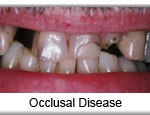It is fairly well known that one of the common signs a person may have gum or periodontal disease is gum bleeding on brushing. This bleeding comes from red inflamed marginal gingival. Gingiva is the technical word for gums, and marginal gingiva refers to that portion of the gum that rests directly against the teeth.
Red inflamed gingival is often associated with dental plaque and tartar. Dental plaque is a complex sugar molecule made by bacteria normally present in most people’s mouths. Plaque is a soft “fuzzy” film that builds up around teeth daily. Only thorough tooth brushing and dental flossing each day can prevent this film from sticking to your teeth. Because new plaque builds up each day, you could never go to the dentist frequently enough to prevent plaque from collecting around teeth.
Plaque is often confused with tartar. The technical word for tartar is calculus, and this word is frequently used instead of the word tartar. Tartar or calculus is a hard crystallized mineral deposit that forms between and over the teeth. Calculus requires the presence of soft plaque on the teeth to form these mineralized crystals. Most saliva is rich in minerals that are invisible when dissolved in saliva. But, when the mineral-rich saliva encounters plaque on the teeth, it crystallizes and forms the visible product, calculus. Until pigmented food, drink or tobacco products are consumed, most calculus blends in with the color of the teeth making it less noticeable until a significant quantity has built up around the teeth. The mineral-rich saliva flows into the mouth from ducts located under the forward part of the tongue adjacent to the back of the lower front teeth and from the cheeks opposite the upper molars.
Typically, the lower front teeth and the upper molars first build calculus, though calculus can build on all teeth. Calculus is never present when the teeth are kept completely free of plaque daily.
We all know that the human mouth is full of germs or bacteria. Dental plaque can be produced only when the bacteria s.mutans is present in the mouth. The s.mutans bacteria takes sugar molecules from the mouth and saliva and makes longer sugar molecules called polysaccharides. The long sugar molecule made by linking many small sugar molecules is dental plaque. So a diet rich in small sugar molecules, such as sucrose, the sugar associated with most candies and baked sweets, is an ideal stimulus for the s.mutans bacteria to form the polysaccharide we know as dental plaque.
Dental plaque is somewhat sticky, and once it sticks to the teeth, it forms a mesh or a bed, if you will, that acid-producing bacteria can live in. Over time these acids cause the densely hard outer enamel of the teeth to break down or decalcify. This is how “decay” or “cavities” are formed.
Plaque also allows calculus formation against teeth. When calculus attaches to the teeth, the gums (marginal gingival) cannot be in the tooth’s normal close relationship. The calculus is responsible for disrupting the gum seal against the teeth and makes it possible for disease-causing bacteria to invade the roots of the teeth. This is how gum disease starts and progresses. The invading bacteria produce enzymes called proteolytic enzymes that further deteriorate the ligament between the roots of the teeth and the bone attached to the (periodontal) ligament. As this bone is what retains the tooth in the mouth, its loss ultimately means the loss of the tooth or teeth experiencing this process if left unchecked.

Chandler Dentist
Kelly Jorn Cook, DDS
3800 W Ray Rd, Ste 19
Chandler, AZ 85226
Office: (480) 899-4477

